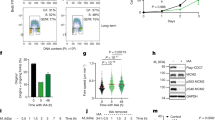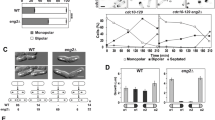Abstract
The accurate spatial and temporal coordination of cell polarization with DNA replication and segregation guarantees the fidelity of genetic transmission. Here we report that in Saccharomyces cerevisiae, a build-up or burst of G1 cyclin-dependent kinase (CDK) activity through activation of the cyclin genes CLN1,2 and PCL1,2 is essential for cell morphogenesis, but not for other events associated with the G1–S-phase transition, including DNA replication. Strains lacking a burst of late-G1 cyclin–CDK activity (LG1C−) undergo a catastrophic morphogenesis and halt the nuclear cycle at the morphogenesis checkpoint in G2 phase. Consistent with a role in morphogenesis, the Pho85 G1 cyclins Pcl1 and Pcl2 show a unique pattern of localization to sites of polarized cell growth, and strains lacking PCL1 and PCL2 show genetic interactions with the cell polarity GTPase Cdc42, its regulators and downstream effectors. Our data suggest that inability to assemble a septin ring and localize the GTP exchange factor Cdc24 at the incipient bud site may be the primary morphogenetic defects in LG1C-depleted cells. We conclude that a burst of late G1 cyclin–CDK activity is essential for establishing cell polarity and development of the cleavage apparatus.
This is a preview of subscription content, access via your institution
Access options
Subscribe to this journal
Receive 12 print issues and online access
$209.00 per year
only $17.42 per issue
Buy this article
- Purchase on Springer Link
- Instant access to full article PDF
Prices may be subject to local taxes which are calculated during checkout





Similar content being viewed by others
References
Tyers, M. & Jorgensen, P. The yeast nucleus: frontiers in molecular biology (eds Fantes, P. & Beggs, J.) 58–105 (Oxford University Press, Oxford, 2000).
Nash, P. et al. Multisite phosphorylation of a CDK inhibitor sets a threshold for the onset of DNA replication. Nature 414, 514–521 (2001).
Measday, V., Moore, L., Ogas, J., Tyers, M. & Andrews, B. The PCL2 (ORFD)-PHO85 cyclin-dependent kinase complex: a cell cycle regulator in yeast. Science 266, 1391–1395 (1994).
Gulli, M.P. & Peter, M. Temporal and spatial regulation of Rho-type guanine-nucleotide exchange factors: the yeast perspective. Genes Dev. 15, 365–379 (2001).
Andrews, B. & Measday, V. The cyclin family of budding yeast: abundant use of a good idea. Trends Genet. 14, 66–72 (1998).
Dirick, L., Bohm, T. & Nasmyth, K. Roles and regulation of the Cln-Cdc28 kinases at the start of the cell cycle of Saccharomyces cerevisiae. EMBO J. 14, 4803–4813 (1995).
Nishizawa, M., Kawasumi, M., Fujino, M. & Toh-e, A. Phosphorylation of Sic1, a cyclin-dependent kinase (Cdk) inhibitor, by Cdk including Pho85 kinase is required for its prompt degradation. Mol. Biol. Cell 9, 2393–2405 (1998).
Tennyson, C., Lee, J. & Andrews, B. A role for the Pcl9-Pho85 cyclin-Cdk complex at the M/G1 boundary in Saccharomyces cerevisiae. Mol. Microbiol. 28, 69–79 (1998).
Miller, M.E. & Cross, F.R. Mechanisms controlling subcellular localization of the G(1) cyclins Cln2p and Cln3p in budding yeast. Mol. Cell. Biol. 21, 6292–6311 (2001).
Edgington, N.P. & Futcher, B. Relationship between the function and location of G1 cyclins in S. cerevisiae. J. Cell Sci. 114, 4599–4611 (2001).
Harvey, S.L. & Kellogg, D.R. Conservation of mechanisms controlling entry into mitosis: budding yeast Wee1 delays entry into mitosis and is required for cell size control. Curr. Biol. 13, 264–275 (2003).
Rupes, I. Checking cell size in yeast. Trends Genet. 18, 479–485 (2002).
Lew, D.J. & Reed, S.I. A cell cycle checkpoint monitors cell morphogenesis in budding yeast. J. Cell Biol. 129, 739–749 (1995).
Toenjes, K.A., Sawyer, M.M. & Johnson, D.I. The guanine-nucleotide-exchange factor Cdc24p is targeted to the nucleus and polarized growth sites. Curr. Biol. 9, 1183–1186 (1999).
Nern, A. & Arkowitz, R.A. Nucleocytoplasmic shuttling of the Cdc42p exchange factor Cdc24p. J. Cell Biol. 148, 1115–1122 (2000).
Shimada, Y., Gulli, M.P. & Peter, M. Nuclear sequestration of the exchange factor Cdc24 by Far1 regulates cell polarity during yeast mating. Nature Cell Biol. 2, 117–124 (2000).
Kim, H.B., Haarer, B.K. & Pringle, J.R. Cellular morphogenesis in the Saccharomyces cerevisiae cell cycle: localization of the CDC3 gene product and the timing of events at the budding site. J. Cell Biol. 112, 535–544 (1991).
Jaquenoud, M. & Peter, M. Gic2p may link activated Cdc42p to components involved in actin polarization, including Bni1p and Bud6p (Aip3p). Mol. Cell. Biol. 20, 6244–6258 (2000).
Cvrckova, F., De Virgilio, C., Manser, E., Pringle, J.R. & Nasmyth, K. Ste20-like protein kinases are required for normal localization of cell growth and for cytokinesis in budding yeast. Genes Dev. 9, 1817–1830 (1995).
Benton, B.K., Tinkelenberg, A., Gonzalez, I. & Cross, F.R. Cla4p, a Saccharomyces cerevisiae Cdc42p-activated kinase involved in cytokinesis, is activated at mitosis. Mol. Cell. Biol. 17, 5067–5076 (1997).
Lenburg, M.E. & O'Shea, E.K. Genetic evidence for a morphogenetic function of the Saccharomyces cerevisiae Pho85 cyclin-dependent kinase. Genetics 157, 39–51 (2001).
Huang, D., Moffat, J. & Andrews, B. Dissection of a complex phenotype by functional genomics reveals roles for the yeast cyclin-dependent protein kinase Pho85 in stress adaptation and cell integrity. Mol. Cell. Biol. 22, 5076–5088 (2002).
Kozminski, K.G., Chen, A.J., Rodal, A.A. & Drubin, D.G. Functions and functional domains of the GTPase Cdc42p. Mol. Biol. Cell 11, 339–354 (2000).
Pruyne, D. & Bretscher, A. Polarization of cell growth in yeast I. Establishment and maintenance of polarity sites. J. Cell Sci. 113, 365–375 (2000).
Miller, M.E. & Cross, F.R. Distinct subcellular localization patterns contribute to functional specificity of the Cln2 and Cln3 cyclins of Saccharomyces cerevisiae. Mol. Cell. Biol. 20, 542–555 (2000).
Tyers, M., Tokiwa, G. & Futcher, B. Comparison of the Saccharomyces cerevisiae G1 cyclins: Cln3 may be an upstream activator of Cln1, Cln2 and other cyclins. EMBO J. 12, 1955–1968 (1993).
Gulli, M.P. et al. Phosphorylation of the Cdc42 exchange factor Cdc24 by the PAK-like kinase Cla4 may regulate polarized growth in yeast. Molecular Cell 6, 1155–1167 (2000).
Longtine, M.S. et al. Additional modules for versatile and economical PCR-based gene deletion and modification in Saccharomyces cerevisiae. Yeast 14, 953–961 (1998).
Marschall, L.G., Jeng, R.L., Mulholland, J. & Stearns, T. Analysis of tub4p, a yeast γ-tubulin-like protein: implications for microtubule-organizing center function. J. Cell Biol. 134, 443–454 (1996).
Huang, D., Patrick, G., Moffatt, J., Tsai, L.-H. & Andrews, B. Mammalian Cdk5 is a functional homologue of the budding yeast Pho85 cyclin-dependent protein kinase. Proc. Natl Acad. Sci. USA 96, 14445–14450 (1999).
Acknowledgements
We thank M. Tyers and members of the Andrews' lab for discussions, and C. Boone for comments on the manuscript. We also thank M. Peter, J. Pringle, C. Boone, M. Tyers, J. Tang and E. Bi for plasmids and antibodies. J.M. was supported by a Canadian Institutes of Health Research pre-doctoral award and University of Toronto Open Fellowship. This work was supported by operating grants to B.A. from the National Cancer Institute of Canada with funds from the Canadian Cancer Society and the Canadian Institutes of Health Research.
Author information
Authors and Affiliations
Corresponding author
Ethics declarations
Competing interests
The authors declare no competing financial interests.
Supplementary information
Supplementary Information, Fig. S1
Supplementary Information, Fig. S2 (PDF 539 kb)
Supplementary Information, Table 1
Supplementary Information, Table 2
Supplementary Information, Table 3
Rights and permissions
About this article
Cite this article
Moffat, J., Andrews, B. Late-G1 cyclin–CDK activity is essential for control of cell morphogenesis in budding yeast. Nat Cell Biol 6, 59–66 (2004). https://doi.org/10.1038/ncb1078
Received:
Accepted:
Published:
Issue Date:
DOI: https://doi.org/10.1038/ncb1078
This article is cited by
-
Positive feedback of G1 cyclins ensures coherent cell cycle entry
Nature (2008)
-
Phosphorylation of Rga2, a Cdc42 GAP, by CDK/Hgc1 is crucial for Candida albicans hyphal growth
The EMBO Journal (2007)
-
Activation of the Cdc42p GTPase by cyclin-dependent protein kinases in budding yeast
The EMBO Journal (2007)
-
Cdk1 coordinates cell-surface growth with the cell cycle
Nature Cell Biology (2007)
-
Multiple levels of cyclin specificity in cell-cycle control
Nature Reviews Molecular Cell Biology (2007)



